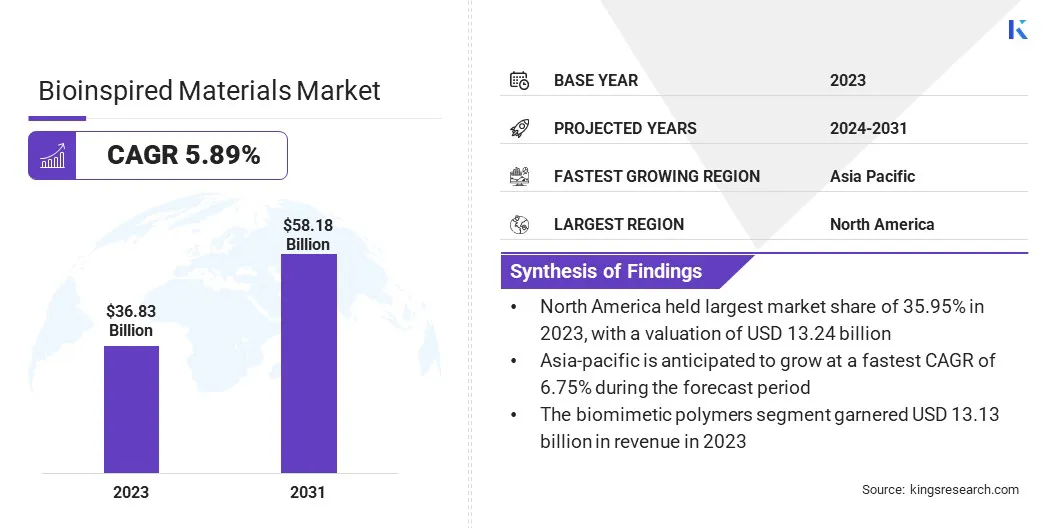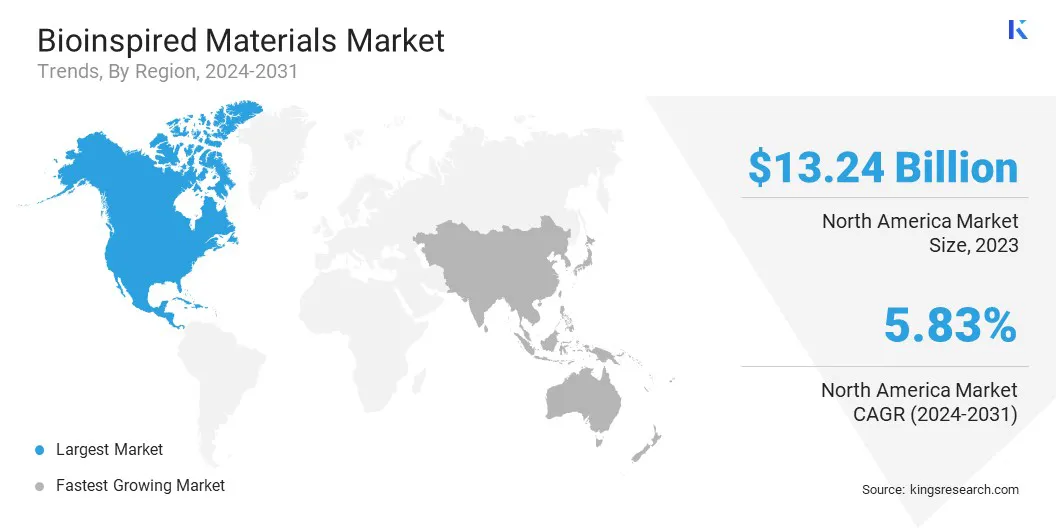Market Definition
The market focuses on the development, production, and commercialization of materials designed, based on the principles and structures found in nature. These materials aim to replicate the unique mechanical, chemical, optical, and functional properties observed in natural systems to achieve superior performance, sustainability, and innovation across various sectors. The report provides insights into the core drivers of market growth, supported by an in-depth evaluation of industry trends and regulatory frameworks.
Bioinspired Materials Market Overview
The global bioinspired materials market size was valued at USD 36.83 billion in 2023 and is projected to grow from USD 38.97 billion in 2024 to USD 58.18 billion by 2031, exhibiting a CAGR of 5.89% during the forecast period.
This growth is attributed to the increasing demand for sustainable and high-performance materials across industries such as automotive, healthcare, construction, and packaging. The rising awareness of environmental concerns and the need for eco-friendly alternatives is driving the growth of the market.
Major companies operating in the bioinspired materials industry are Vandstrom, Sharklet Technologies, The Corrales Comment, Terra Vera Corp, BASF, ADDMAN Engineering, Bioxegy Group SARL, Ford Motor Company, nanoloom.co, SanaHeal, ECOSTP TECHNOLOGIES (P) LTD, Biohm Ltd, The QinetiQ Group, New Iridium, and Biome Renewables Inc.
Furthermore, advancements in material science and nanotechnology, along with the growing adoption of bioinspired materials for applications such as tissue engineering, smart coatings, and lightweight composites, are further fueling the market's growth.
- In November 2023, the U.S. Naval Research Laboratory (NRL) launched the Microbes for Multiple Uses in Space Project (MELSP) aboard the International Space Station. The mission aims to explore bioinspired materials by culturing microbial species in microgravity, focusing on melanin production for applications in radiation protection and bioelectronics.
 Key Highlights
Key Highlights
- The bioinspired materials industry size was valued at USD 36.83 billion in 2023.
- The market is projected to grow at a CAGR of 5.89% from 2024 to 2031.
- North America held a market share of 35.95% in 2023, with a valuation of USD 13.24 billion.
- The biomimetic polymers segment garnered USD 13.13 billion in revenue in 2023.
- The medical segment is expected to reach USD 15.90 billion by 2031.
- The market in Asia Pacific is anticipated to grow at a CAGR of 6.75% during the forecast period.
Market Driver
"Rising Demand for Sustainable Materials"
The growing demand for sustainable materials is fueling the bioinspired materials market. These materials offer eco-friendly alternatives, reduce dependence on fossil-based inputs, and support circular economy goals across packaging, construction, and healthcare sectors.
Increasing awareness of climate change, resource depletion, and environmental pollution has accelerated the shift toward materials that are biodegradable, recyclable, and energy-efficient.
Bioinspired materials offer high performance while minimizing environmental impact, making them an ideal solution for industries seeking to meet sustainability standards without compromising on quality or functionality.
- In March 2025, researchers at the University of Turku developed a novel biomimetic fabrication technique inspired by plant leaf skeletons. This method replicates fractal microstructures, creating flexible surfaces ideal for wearable sensors and electronic skins. It is more sustainable than traditional cleanroom methods, requiring less energy and enabling the use of sustainable polymers, reducing environmental impact.
Market Challenge
"High Research and Development Costs"
A significant challenge hindering the growth of the bioinspired materials market is the high research and development costs associated with replicating complex natural systems.
Unlike traditional materials, bioinspired alternatives require a deep understanding of biological mechanisms and advanced technologies to mimic their structure and function accurately. This process often requires multi-phase experimentation and cross-disciplinary collaboration across biology, chemistry, physics, and engineering.
It also depends on advanced tools, including nanofabrication equipment, simulation software, and high-resolution imaging systems These factors result in longer development timelines and higher upfront investment, which can be a major hurdle for startups and small-to-medium enterprises.
To address this challenge, market players are engaging in collaborative research initiatives involving academia and government to share resources, expertise, and infrastructure. Companies are focusing on pilot projects that demonstrate the value of bioinspired materials, attract investors, and justify long-term investments.
Advances in scalable manufacturing technologies like 3D printing, biofabrication, and modular design are further reducing production costs and improving the commercial viability of these innovative materials.
Market Trend
"Expansion in Medical and Healthcare Applications"
Bioinspired materials are increasingly being adopted in medical and healthcare applications due to their ability to replicate the structure, function, and adaptability of biological systems.
These materials are being used to develop implants, prosthetics, and tissue scaffolds that offer superior biocompatibility, mechanical strength, and integration with human tissues. For example, materials inspired by bone microarchitecture or skin elasticity improve healing outcomes and reduce the risk of implant rejection.
- In August 2023, the National Center for Biotechnology Information (NCBI) published a comprehensive review titled "Bioactive Materials for Bone Regeneration: Biomolecules and Delivery Systems" which explores the potential of bioinspired materials in enhancing bone healing. It focuses on the use of biomolecules such as proteins, peptides, and lipids, and discusses how these bioactive substances can be delivered through scaffolds to promote tissue regeneration.
In addition, bioinspired hydrogels and smart materials are advancing drug delivery systems, by enabling controlled release and targeted therapy. This trend is supported by the growing demand for personalized medicine and minimally invasive treatments, making bioinspired materials a critical component of next-generation healthcare solutions.
- In May 2024, the National Center for Biotechnology Information (NCBI) published an article titled "Bioinspired Materials for Wearable Devices and Point-of-Care Testing of Cancer." The article explores the application of bioinspired materials in developing wearable devices and biosensors to improve cancer detection and management.
Bioinspired Materials Market Report Snapshot
|
Segmentation
|
Details
|
|
By Material
|
Biomimetic Polymers, Biomimetic Ceramics & Glass, Biomimetic Metals & Alloys, and Others
|
|
By Application
|
Medical, Automotive, Defense, Electronics, and Others
|
|
By Region
|
North America: U.S., Canada, Mexico
|
|
Europe: France, UK, Spain, Germany, Italy, Russia, Rest of Europe
|
|
Asia-Pacific: China, Japan, India, Australia, ASEAN, South Korea, Rest of Asia-Pacific
|
|
Middle East & Africa: Turkey, U.A.E., Saudi Arabia, South Africa, Rest of Middle East & Africa
|
|
South America: Brazil, Argentina, Rest of South America
|
Market Segmentation
- By Material (Biomimetic Polymers, Biomimetic Ceramics & Glass, Biomimetic Metals & Alloys, and Others): The biomimetic polymers segment earned USD 13.13 billion in 2023, due to their versatility, lightweight nature, and widespread use across biomedical, packaging, and industrial applications.
- By Application (Medical, Automotive, Defense, Electronics, and Others): The medical segment held 27.30% of the market in 2023, due to the increasing use of bioinspired materials in implants, tissue engineering, and drug delivery systems that enhance biocompatibility and patient outcomes.
Bioinspired Materials Market Regional Analysis
Based on region, the bioinspired materials industry has been classified into North America, Europe, Asia Pacific, Middle East & Africa, and South America.
 The North America bioinspired materials market share stood around 35.95% in 2023, with a valuation of USD 13.24 billion. This dominance is attributed to the region’s robust research infrastructure, the strong presence of biotechnology and medical device industries, and early adoption of advanced materials in sectors such as healthcare, defense, and electronics.
The North America bioinspired materials market share stood around 35.95% in 2023, with a valuation of USD 13.24 billion. This dominance is attributed to the region’s robust research infrastructure, the strong presence of biotechnology and medical device industries, and early adoption of advanced materials in sectors such as healthcare, defense, and electronics.
Furthermore, significant investments in R&D, along with government initiatives like those from the National Science Foundation (NSF) promoting bioinspired innovation, are fostering market growth.
The region’s focus on sustainable technologies and the integration of bioinspired materials into next-generation applications further strengthens North America’s leadership in the market.
- In December 2024, Axoft received approval for initiating its first human clinical trial at The Panama Clinic. This clinical trial will be the first authorized use of a bio-inspired material in humans, developed to closely replicate the softness of the brain tissue and enhance the long-term performance of implantable brain-computer interfaces.
- In February 2024, the U.S. National Science Foundation (NSF) revealed a USD 9.75 million investment, to fund 15 interdisciplinary teams under its Convergence Accelerator Track M: Bio-Inspired Design Innovations. These teams will work on creating transformative solutions inspired by nature to tackle critical societal and economic challenges.
The bioinspired materials industry in Asia-Pacific is poised for significant growth at a robust CAGR of 6.75% over the forecast period. This growth is supported by rapid industrialization, expanding healthcare infrastructure, and the increasing demand for sustainable and high-performance materials across emerging economies such as China, India, and Southeast Asian countries.
The region is also witnessing rising investments in advanced manufacturing, nanotechnology, and biomedical research, that are accelerating the adoption of bioinspired materials. Moreover, collaborations between academic institutions and industry players are driving innovation and commercialization, thereby driving the growth of the market in Asia-Pacific.
Regulatory Frameworks
- In the United States, the FDA's Quality System Regulation (QSR) under 21 CFR Part 820, governs the manufacturing of medical devices, including those using bioinspired materials. It requires manufacturers to establish a quality management system to ensure compliance with safety and performance standards, including design controls and documentation.
- In Japan, the Chemical Substances Control Law (CSCL) regulates the manufacturing and use of chemical substances, including bioinspired materials. New substances must be notified to the Ministry of Economy, Trade, and Industry (METI), and materials containing Class I or Class II Specified Chemical Substances, require prior approval and may face restrictions on use.
Competitive Landscape
The market is characterized by a competitive landscape, featuring a mix of global chemical and materials science corporations, alongside agile biotech startups. Companies are prioritizing innovation, sustainability, and strategic collaborations to develop advanced, nature-inspired solutions across a range of industries.
Leading players are heavily investing in R&D to create materials that mimic biological structures and functions, particularly for use in medical, aerospace, and consumer goods applications. Strategic partnerships with research institutions and acquisitions of niche technology firms are enabling companies to expand their technological capabilities and market presence.
The increasing demand for sustainable and high-performance alternatives to traditional materials is driving competition, with market participants focusing on tailored product development, to meet evolving industry-specific requirements.
List of Key Companies in Bioinspired Materials Market:
- Vandstrom
- Sharklet Technologies
- The Corrales Comment
- Terra Vera Corp
- BASF
- ADDMAN Engineering
- Bioxegy Group SARL
- Ford Motor Company
- nanoloom.co
- SanaHeal
- ECOSTP TECHNOLOGIES (P) LTD
- Biohm Ltd
- The QinetiQ Group
- New Iridium
- Biome Renewables Inc.
Recent Developments (M&A/Partnerships/Agreements/New Product Launch)
- In August 2024, Terra Vera launched ApiVera, a division focused on preserving bee populations and enhancing bee health. ApiVera develops bee-specific products to combat parasites, using biodegradable and non-toxic biomimicry-based solutions.
can

 Key Highlights
Key Highlights The North America bioinspired materials market share stood around 35.95% in 2023, with a valuation of USD 13.24 billion. This dominance is attributed to the region’s robust research infrastructure, the strong presence of biotechnology and medical device industries, and early adoption of advanced materials in sectors such as healthcare, defense, and electronics.
The North America bioinspired materials market share stood around 35.95% in 2023, with a valuation of USD 13.24 billion. This dominance is attributed to the region’s robust research infrastructure, the strong presence of biotechnology and medical device industries, and early adoption of advanced materials in sectors such as healthcare, defense, and electronics.